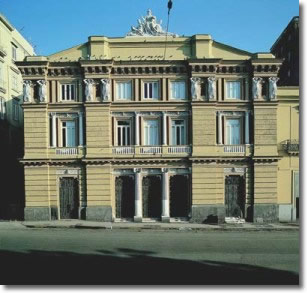
- The Theatre Mercadante
The Theatre Mercadante was born as the Teatro del Fondo, from the name of a military society (Fondo di separazione dei lucri - Division of Profits Fund), who provided for the building in 1777-78 with the funds confiscated to the Dissolved Order of Jesuits, assigning its planning to the Sicilian colonel Francesco Securo. In 1779 the theatre was inaugurated with a performance of the opera "L'infedele fedele" (The Unfaithful Faithful One) by Giovanbattista Lorenzi with music by Cimarosa.
It was renamed Teatro Mercadante in 1870 in honour of the Apulian musician who got his training in Naples. It specialised in opera (both comic opera and serious opera) and was an active participant in the political and cultural changes that came about with the Parthenopean Republic (1799). In this period it became the "Teatro Patriottico" - Patriotic Theatre), with performances of patriotic plays and "patriotic hymns", among which was Cimarosa's, and this gave to the composer the opportunity of remaining in Naples when the monarchy was restored.
With the Restoration, the Mercadante reacquired its function as an opera house and there were performances of operas by composers such as Rossini, Bellini, Donizetti and Verdi. Between the end of the 19th century and the beginning of the 20th, it was the scene of great Italian and International performers: Adelaide Ristori, Fanny Sadowski, Ermete Zacconi, Eleonora Duse, Sarah Bernhardt and Coquelin were the much-applauded protagonists of that great season, without forgetting of course the great names of the Neapolitan theatre (Antonio Petito, Eduardo Scarpetta, Roberto Bracco), who were also great favourites of the public. Since the theatre always welcomed novelty, in 1914 it housed a much-contested "Futurist Evening" organised by Marinetti. Later, the theatre's great protagonists were Marta Abba and Luigi Pirandello.
From 1920 to 1938 the theatre was closed for purposes of restoration and in 1936 the ceiling was enriched with the tempera painting called "Napoli marinara" (The Mariner's Naples) by Francesco Galante. After further restoration, from 1959 to 1963 it was awarded recognition as a Permanent Theatre under the direction of Franco Enriquez. In 1963 the theatre was closed as being unfit for use because of its problems with statics.
In 1973 the theatre was transferred from State property to Commune of Naples property and in 1979 begun the latest restoration with the creation of new services. The decade 1980-1990 saw a very varied programme: the project "Theatre of Naples - Theatre of the Mediterranean"(1990/92) directed by Maurizio Scaparro, a number of pretigious performances of Roberto De Simone (Stravinskij's "Histoire du Soldat" and "La Gatta Cenerentola" by De Simone himself) and the project of International Music Weeks.
Recently, since 1995, the Mercadante has been intensively active with interesting theatre seasons promoted by the Commune of Naples, by the Ente Teatrale Italiano and the Teatro Pubblico Campano, together with contemporary theatre projects, video shows, a theatre school, so becoming a cultural point of reference for the city. Since the 2003-2004 theatre season the Mercadante has been under the management of the Associazione Teatro Stabile of the city of Naples.